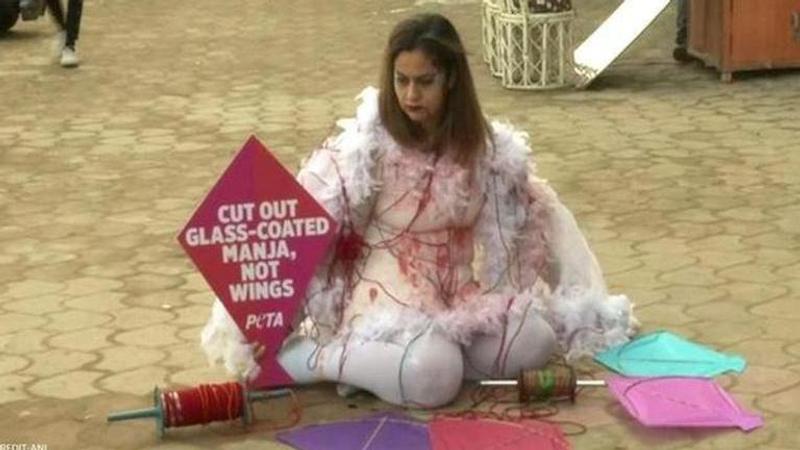Published 14:10 IST, January 11th 2020
PETA activist laments the plight of birds injured by kite manjha
Gunjan Sikka, a PETA activist, donned herself as an injured bird bleeding profusely, to protest against the glass-coated manjhas in Ludhiana, Punjab on Friday.

Lamenting the plight of birds that get fatally wounded by the glass-coated 'manjhas' during the festival of Lohri when kites galore the sky, a PETA activist on Friday donned herself as a bird bleeding profusely due to slits all over the body. Every year, several birds succumb to their injuries or are crippled for life due to the wounds received from the glass-coated manjhas. Gunjan Sikka, a social activist of PETA World also held a kite-shaped poster, which read: "Cut out glass-coated manjha, not wings".
Speaking to a news agency, Gunjan Sikka said, "I am protesting against the manufacturing of glass-coated manjhas, and I appeal to all the manufacturers and the people who buy them, to stop using such manjhas, as they cause too much harm to birds, animals and even people. Through the use of manjhas, you can even get handicapped for life. As our environment is run by all living beings, I appeal the government to look into this matter, as it is very important for our lives."
Rajasthan bans Chinese Manjha
The Rajasthan government on Tuesday banned the sale of Chinese manjha, which is a plastic or synthetic string used for flying kites, officials said. The order was issued during a meeting held by Chief Minister Ashok Gehlot and the matter of injuries due to the use of manjha was discussed in it, they said.
On the CM's directions, Additional Chief Secretary (Home) Rajeeva Swarup issued a letter to Jaipur and Jodhpur police commissioners and all district magistrates, asking them to immediately issue prohibitory orders under section 144 of the CrPC to ban the sale and stock of such thread. He also asked them to initiate awareness in schools and colleges, apprising the students of the danger of using such strings for flying kites.
About Lohri
Lohri, primarily celebrated in the Punjab region by Sikhs and Hindus, marks the end of the winter season. Bonfire and folk songs are a major part of the celebration, and a puja parikrama around the bonfire is performed followed by the distribution of Prasad. The festival is observed the night before Makar Sankranti or Maghi and falls on the same date nearly every year.
(With inputs from agencies)
Updated 14:10 IST, January 11th 2020




